Callistemon pityoides
Syn. Melaleuca pityoides
For many years confused with Callistemon sieberi
 |
 |
Alpine Bottlebrush
Callistemon pityoides F.Muell.
Melaleuca pityoides (F.Muell.) Craven
The Alpine Bottlebrush (Callistemon pityoides), as this common name suggests, grows naturally at altitudes from above 2000 m down to around 900 m. It is found commonly in and around sphagnum bogs and swamps and along watercourses in Queensland, New South Wales and Victoria. In NSW it occurs in the Snowy Mountains region, the higher Blue Mountains and higher parts of the northern tablelands, and in Victoria in the north-east alps. In Queensland, it occurs near Racecourse Creek north-east of Wallangarra.
 The
specimens growing in the Australian National Botanic Gardens have proven to
be good garden subjects, particularly in wetter areas. The plants originating
from seed collected from the higher altitudes of its range have only attained
a height of 1 m in eight years, whilst those grown from seed collected at lower
altitudes have reached a height of slightly more than 3 m in the same time.
A spread of nearly 2 m can be expected from the large forms. Once the above
dimensions have been reached the growth rate drops off sharply.
The
specimens growing in the Australian National Botanic Gardens have proven to
be good garden subjects, particularly in wetter areas. The plants originating
from seed collected from the higher altitudes of its range have only attained
a height of 1 m in eight years, whilst those grown from seed collected at lower
altitudes have reached a height of slightly more than 3 m in the same time.
A spread of nearly 2 m can be expected from the large forms. Once the above
dimensions have been reached the growth rate drops off sharply.
One of the attractive features exhibited by C. pityoides are the colourful bracts which surround the developing buds. These buds first become evident towards the end of July in Canberra and as early spring approaches the protective bracts become an attractive and very distinctive pink-bronze colour. By the first week in November, the showy bracts have become a less conspicuous green and the buds burst to release their captive stamens.
This plant forms dense thickets that are usually between 1 m and 2.5 m in height. In areas where this plant has established itself, it often does so to the total exclusion of all other plants.
In its mountain habitat Callistemon pityoides comes into flower late in the season, but when it does bloom masses of small, dense, cream brushes are borne on the ends of the branches. Pink forms may be seen on rare occasions.
The flowers are produced on a dense terminal spike out of which grows a leafy shoot as flowering comes to an end. Seed, which is very small, is produced in small almost globular woody capsules about 5-6 mm in diameter. Seed is shed through a very small opening when ripe.
The leaves are narrow and sharply pointed, being 1.5 - 2.5 cm in length and less than 3 mm wide. The under-surface usually has scattered oil glands. Silky hairs cover the underside of the older leaves nearest the stem while the younger leaves are entirely covered on both sides with dense silky hairs.
Callistemon pityoides can be readily propagated from seed extracted from the oldest capsules collected when at least one year old. The capsules should be placed in a paper bag or a saucer-like dish to dry. As moisture is lost and the capsules become dry they will open, releasing the very small seed. Tip cuttings using the new season's growth can also be used.
This plant has proven itself in the Australian National Botanic Gardens to be particularly suited to wetter areas although it will also grow successfully on drier sites. It is relatively free from pests and diseases but like most Callistemon species, leaf distortion thrips, Callistemon Tip Moth and sawfly larvae. To limit excessive damage from these pests growers should consider a range of control options. Chemical control should focus on lower-toxicity products that cause limited environmental damage. Contact local experts for advice.
Text by ANBG staff (1976)
Name meaning: Callistemon pityoidesCallistemon - from two Greek words, kallistos, most beautiful, and stemon, a stamen pityoides - from Greek pitys, pine and oides, like; referring to the leaves |
![An Australian Government Initiative [logo]](/images/austgovt_brown_90px.gif)

